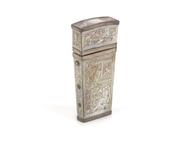







"Cardiac Stimulator", a type of pacemaker designed at St. George's Hospital, London, made by Firth Cleveland Ltd., Glamorgan, c1961
This ‘Cardiac Stimulator’ stimulates the heart to produce a normal rhythm. It is used after heart failure or irregularity caused by an attack of Stokes Adams Disease. An attack involves a temporary stop of the heartbeat. Unconsciousness follows because the brain is starved of oxygen. It can result in full cardiac arrest, particularly during surgical operations involving cardiac depressant drugs. These decrease heart rate to perform heart surgery. The machine operates off both batteries and mains electricity. It was made by Firth Cleveland Limited in Wales. The manufacturer suggests the machine should be always at hand in the operating theatre. In the event of a ‘ventricular standstill’, the heart must be started within three to five minutes to avoid brain damage.
Details
- Category:
- Therapeutics
- Object Number:
- 1988-305
- type:
- cardiac pacemaker
- credit:
- Llandough Hospital




